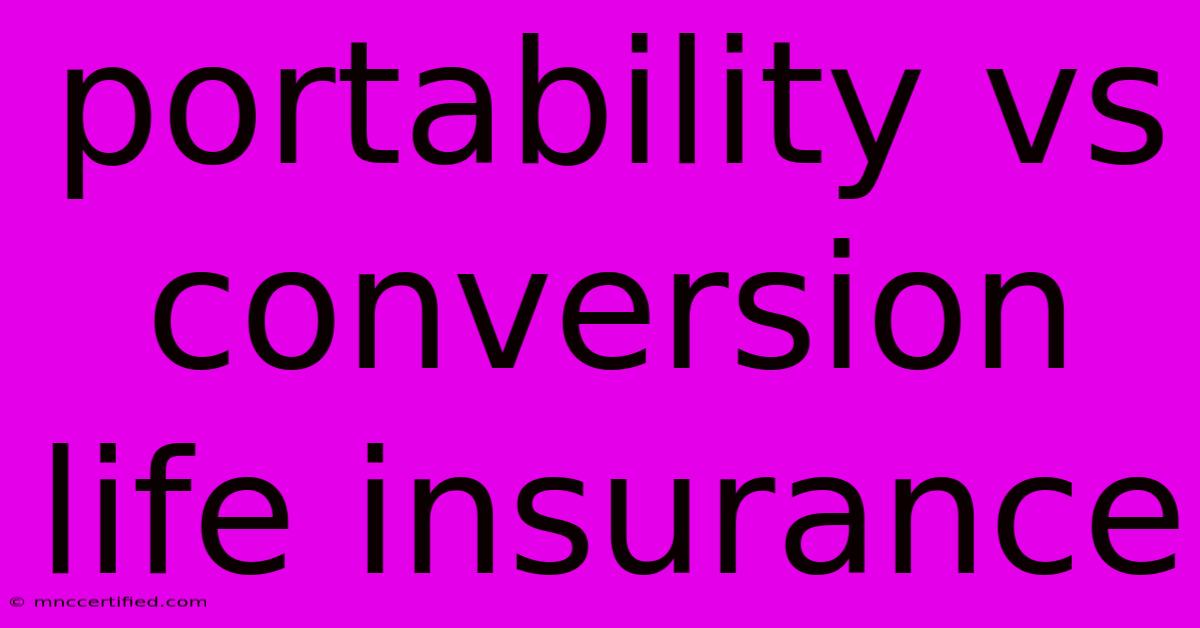Portability Vs Conversion Life Insurance

Table of Contents
Portability vs. Conversion: Navigating the Life Insurance Maze
Life insurance offers a crucial safety net for your loved ones in the event of your passing. But with diverse types and features, choosing the right policy can feel overwhelming. Two popular options – portable life insurance and convertible life insurance – offer distinct advantages. This article delves into their key differences, helping you make an informed decision.
Understanding Portability in Life Insurance
Portability refers to the ability to transfer your existing life insurance policy to a new insurer without undergoing a medical examination. It typically applies to group life insurance policies, often offered by employers or professional organizations.
How it Works:
- Your employer or organization initially underwrites the group policy, covering all participants.
- If you leave the employer or organization, you have the option to port your coverage to a new individual policy.
- The new policy will likely have higher premiums due to the lack of a medical exam, reflecting your current health status.
- However, portability ensures continued life insurance coverage without the need for medical underwriting, offering valuable peace of mind.
Benefits:
- Guaranteed coverage: No medical examination required, ensuring uninterrupted protection.
- Flexibility: Allows you to maintain life insurance even after leaving your employer.
Drawbacks:
- Potentially higher premiums: Reflects your current health and age at the time of conversion.
- Limited coverage: May not be available for all group policies or may have limitations.
Exploring Conversion in Life Insurance
Convertible life insurance allows you to change your term life insurance policy into a permanent life insurance policy within a specific timeframe.
How it Works:
- You purchase a term life insurance policy, providing coverage for a defined period.
- During the conversion period, usually within the first 10-20 years of the policy, you can convert it to a permanent policy.
- Conversion does not require a medical exam, but your age and health status at the time of conversion will affect the new premium.
Benefits:
- Flexibility: Provides the option to switch to permanent coverage later if your needs change.
- Guaranteed coverage: No medical underwriting required during conversion.
Drawbacks:
- Higher premiums: Permanent life insurance is generally more expensive than term life insurance.
- Limited time frame: Conversion must be initiated within the specified period.
Comparing Portability and Conversion
Portability:
- Applies to group life insurance policies.
- No medical exam required for transferring coverage.
- Higher premiums may apply due to current health status.
Conversion:
- Applies to term life insurance policies.
- No medical exam required for switching to permanent coverage.
- Higher premiums may apply due to age and health status.
Determining the Best Option for You
The choice between portability and conversion depends on your individual circumstances:
- If you have a group life insurance policy: Explore portability options if you're leaving your employer and wish to maintain coverage.
- If you have a term life insurance policy: Consider conversion if you want the long-term protection of permanent life insurance.
Always consult with a financial advisor to thoroughly understand your options and make the best choice for your financial situation.
By understanding the distinctions between portability and conversion, you can make an informed decision that aligns with your life insurance needs. Whether you prioritize continuous coverage or flexible options, choosing the right type of policy provides peace of mind for you and your loved ones.

Thank you for visiting our website wich cover about Portability Vs Conversion Life Insurance. We hope the information provided has been useful to you. Feel free to contact us if you have any questions or need further assistance. See you next time and dont miss to bookmark.
Featured Posts
-
Man Utd Dominate Paok Match Stats
Nov 08, 2024
-
Interest Rates Cut Bank Of England At 4 75
Nov 08, 2024
-
What Insurance Does Wilson Dental Accept
Nov 08, 2024
-
Man Utd 2 0 Paok Game Analysis Nov 7
Nov 08, 2024
-
Security First Insurance Ormond Beach Fl
Nov 08, 2024